Odonata
There are two suborders within the order Odonata: Anisoptera (dragonflies) and Zygoptera (damselflies). Odonata larvae are predators and are characterized by a large, hinged labium (lower jaw). Dragon flies and damsel flies can be identified to family by the shape of the prementum, which is the lower half of the labium.
| Family | Picture | Description | Habitat |
|---|---|---|---|
| Aeshinidae (darner dragon flies) |  |
31-50 mm in length. Aeshididae are large bodied with large contigous compound eyes. They have a flat prementum, and 6-7 segments on a slender antennae. Length 31-50mm | Commonly collected in vegetation along the edges of lakes and ponds and in some slow rivers in woody debris. |
| Calopterygidae (broad winged damselflies) |  |
25-50 mm in length. Caloptergidae prementum has a deep median cleft. Antennae segment 1 (closest to the head) is longer than all other antennae segments. | Commonly found along stream margins clinging to vegetation and woody debris. |
| Cordulagastridae (dragon flies, green eyed skimmes, biddies) | 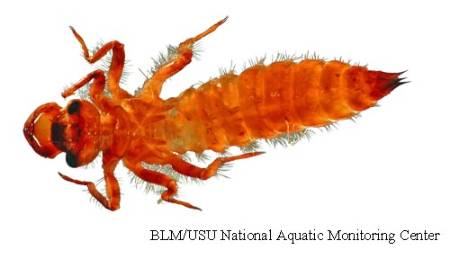 |
35-45 mm in length. Cordulagastridae are very large, hairy, typically dark or metallic, with a broad flat head. The prementum is spoon shaped with irregular, jagged teeth. | Typically found half buried in sand and silt substrates where they wait for prey. |
| Coenagrionidae (narrow winged damselflies) | 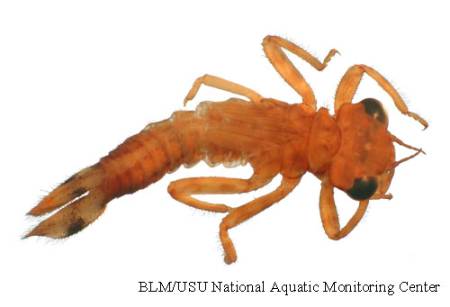 |
15-25 mm in length. Coenagrionidae have a short, triangular prementum without a long narrow base. The caudal lamellae are leaf-like and similar in length. | Found in ponds, lakes, and slow flowing rivers. Most often associated with vegetation. |
| Gomphidae (clubtail dragonflies) | 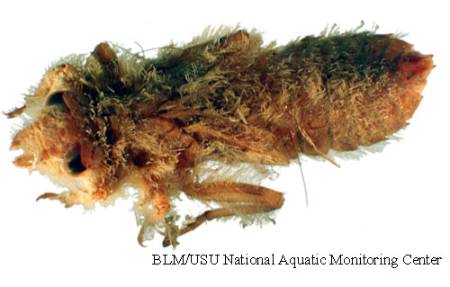 |
4 segmented antennae with enlarged 3rd segment, prementum flat, 2 segmented tarsus on mid legs. Length 5-75mm. | In still, slower moving fresh water |
| Lestidae (spread-winged damselflies) |  |
Long, thin bodies, movable hook on prementum bears setae, adults have wings outstretched at rest. Length 20-30mm. | In still and rapid moving fresh water. |
| Libellulidae (dragon flies, common skimmers) |  |
Short, broad, wide head, vertical face, spoon shaped, dorsal hooks, anal loop on hind wing forms a "foot". Length 20-100mm. | Still, slow moving fresh water |
Trichoptera
Organisms in the Trichoptera Order are commonly known as caddisflies. Caddisflies are known for their ability to produce silk which they use to construct cases (made from sand, rock fragments, plant material) for shelter or to construct nets to catch food. Caddisflies have a low tolerance to pollution, therefore their presence is often used as an indicator of good water quality.
| Family | Picture | Description | Habitat |
|---|---|---|---|
| Apataniidae (smoky wing sedge) | 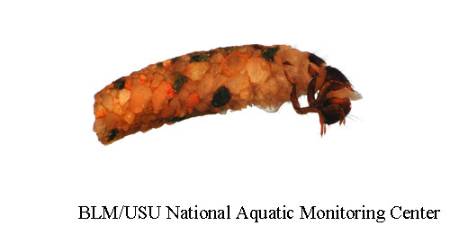 |
8-12 mm in size. Apataniidae have blade-like mandibles and a short antennae located between eye and anterior margin of head. Cases are often round and made from small mineral material. | Typically found in cold springs and streams and occasionally in cold lakes. |
| Brachycentridae (grannoms) | 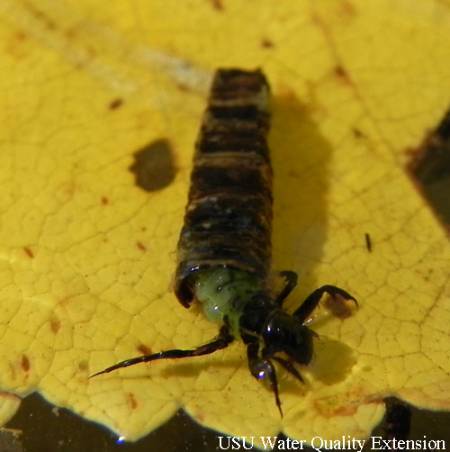 |
6-15 mm in length. Brachycentridae have no abdominal humps on 1st abdominal segment. Middle and hind legs may be longer than front legs. Cases can be tapered, square, or round and made from vegetation, bark, or sand. | Cool, running waters |
| Glossosomatidae (saddlecase maker, little black caddisfly) | 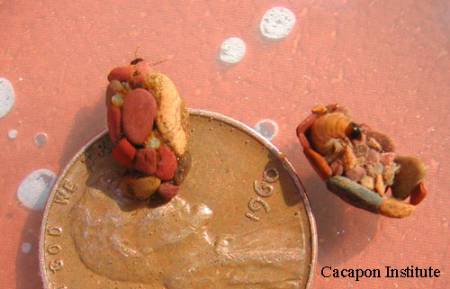 |
3-10 mm in length. Glossosmatidae have short anal prolegs and a sclerotized plate on abdominal segment 9. They lack gills. Case are turtle shell-like domes made from loosely spaced small pebbles. | Cool streams and rivers |
| Helicopsychidae | 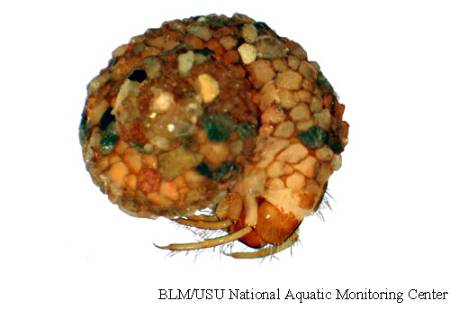 |
3-8 mm in length. Helicopsychidae have a comb-like claw on anal prolegs. Case is distinctly shaped like a snail shell. | Occur in a wide variety of streams and lake littoral zones. |
| Hydropsychidae |  |
10-20+ mm in length. Hydropsychidae have well developed sclerotized plates on all thoracic segments, branched filamentous gills on abdomen, and prolegs with tuft of hairs. They do not build cases. They build small shanties with elaborate nets to catch food. | Generally inhabit flowing waters. |
| Hydroptilidae (micro caddisflies) | 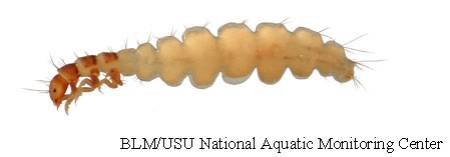 |
2-6 mm in length. Hydroptilidae have sclerotized plates on all thoracic segments, abdominal segments may be expanded, generally without gills. Case is purse or barrel shaped, generally made from sand. | Occur in all types of waters, including springs, streams, ponds, and lakes. |
| Lepidostomatidae (little brown sedges) |  |
7-12 mm in length. Lepidostomatidae are recognized by the closeness of the antennae to the eye, a well developed pro-sternal horn and lack of a dorsal hump on abdominal segment 1. Case is made from sand or vegetation, round or tapered. | Can occur in a variety of habitats, but most commonly found in cold streams. |
| Leptoceridae | 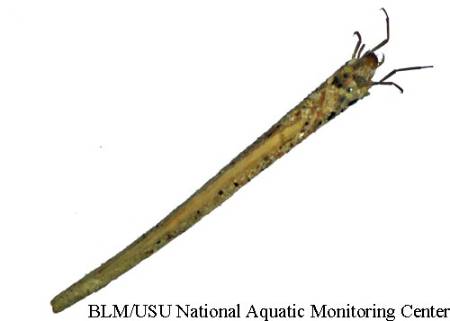 |
7-15 mm in length. Leptoceridae are very slender with hind legs longer than other legs. Case is elongated and made from vegetation and sand. | Occur in warmer waters near aquatic vegetation. |
| Limnephilidae (northern caddisflies) | 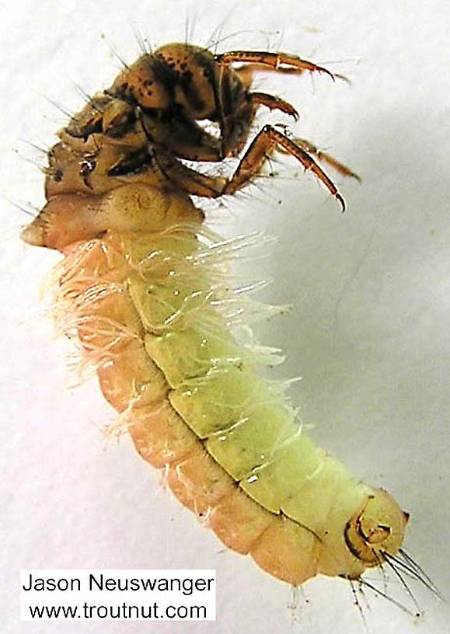 |
6-30 mm in length. Limnephilidae are the largest of the caddisflies. They have a prosternal horn and an antennae located halfway between each eye. Cases can be many sizes and shapes, and made of vegetation or minerals. | Found in all freshwater habitats and can be the dominant family in northern latitudes and higher elevations. |
| Philopotamatidae | 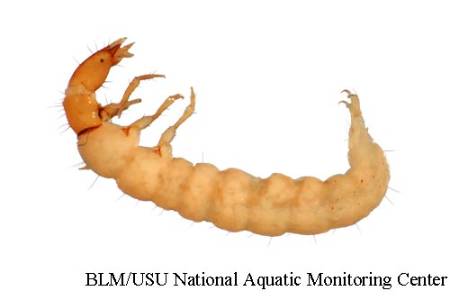 |
10-15 mm in length. Philopotamatidae have an elongate head that is a brownish orange color and a strong ventral curl to abdomen. The abdomen is white and no gills are present. They construct a silken case but are most often collected without a case. | Occur in a variety of habitats, but most often in rapid streams. |
| Phrygaenidae | 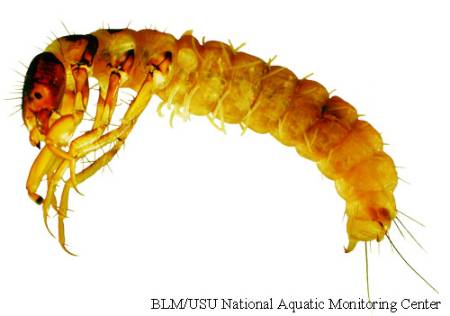 |
20-40 mm in length. Phrygaenidae have an elongate head with bold stripes, and a prominent prosternal horn. Case is made of vegetation. | Most typically inhabit ponds and wetlands or larger slow streams. |
| Polycentropodidae |  |
15-25 mm in length. Polycentropodidae have a pointed, well-developed trochantin. Their abdomen has a lateral fringe of hairs and they often have spots on their heads. Case is silken trumpet shaped tube. They also excavate tunnels in decaying wood. | Found in a variety of flowing waters as well as lake margins. |
| Psychomyiidae |  |
15-25 mm in length. Psychomyiidae have a broad hatchet shaped trochantin, only pronotum has sclerotized plate case - silken retreats, with sand and detritus. Length 15-25 mm. | Cool running waters |
| Rhyacophilidae (green sedge) | 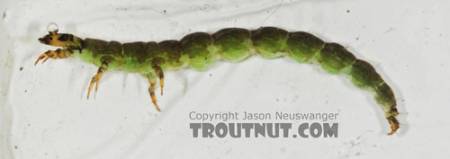 |
12-20 mm in length. Rhycophilidae have a sclerotized plate on the pronotum as well as a dorsal plate on abdominal segment 9, Their anal prolegs are well developed and gills are absent. They do not build a case. | Cool streams in fast water habitats |
| Sericostomatidae |  |
15-25 mm in length. Sericostomatidae have a cluster of 30 dorsal hairs on anal prolegs. Their head lacks pigmentation and they have a hook shaped protrochantin. Case has a cornucopia shape and made from sand and rock pieces. | Occur mostly in flowing waters, but a few species inhabit lake shorelines |
| Uenoidae |  |
10-15 mm in length. Uenoidae have an elongate pronotum and a notch in the anterior of the sclerotized mesonotum. Case is made from coarse rock fragments and are short and stout. | Cold, higher elevation streams |
Lepidoptera
| Family | Picture | Description | Habitat |
|---|---|---|---|
| Pyralidae (aquatic moths) | 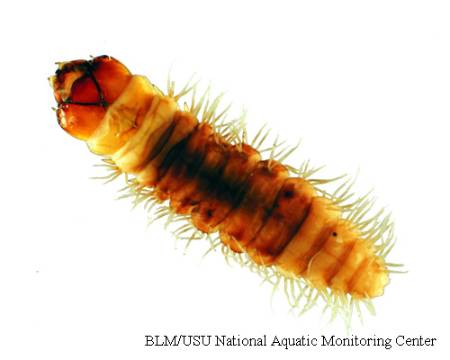 |
Prolegs with crochets on abdominal segments 3-6 and 10, spiracles on prothoracic segment, gills may be present or absent, distinctive x on dorsum of head. | Still and rapid moving fresh water |
Megaloptera
The Megaloptera Order includes dobson flies, alder flies, and helgramites. They are identified by the lateral filaments on each abdominal segment. They are found in the southern half of the state.
| Family | Picture | Description | Habitat |
|---|---|---|---|
| Corydalidae (dobson flies, fish flies, helgramites) |  |
Up to 100 mm in length. Corydalidae have lateral filaments on abdominal segments 1-8 and 2 pairs of lateral hooks on the last abdominal segment. They have large aggressive mandibles. | In Utah, confined to larger streams in the Colorado Plateau. Commonly associated with debris fans and riffles at the mouth of side canyons. |
| Sialidae (alder flies) | 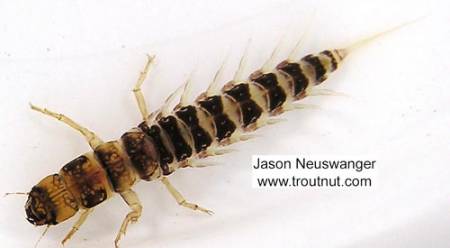 |
Up to 25 mm in length. Sialidae have lateral filaments on abdominal segments 1-7. The last abdominal segment terminates in one single filament. | Commonly found on fine sediments of swamps and large rivers. |
Ephemeroptera
| Family | Picture | Description | Habitat |
|---|---|---|---|
| Ameletidae (primitive minnow mayflies) |  |
Antennae shorter than 2x width of head, striped tail, postlateral corners (spines) on abdomen. Length 6-20 mm. | Rapid moving fresh water, slower water habitats. |
| Ametropodidae (sand minnow mayflies) | 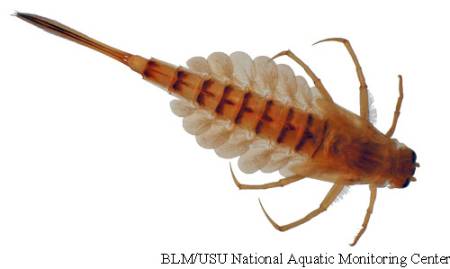 |
Long claws on middle and hind legs, hairs on claws, distinctive lateral fringed gills, 3 fringed tails. Length 14-8 mm. | Rapid moving fresh water, larger rivers. |
| Baetidae (small minnow flies) | 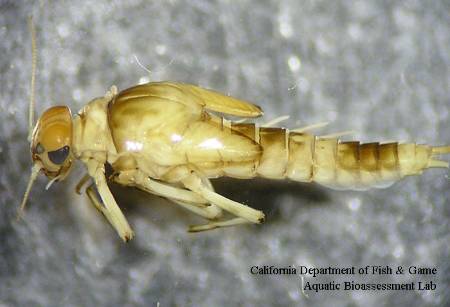 |
Small, stream-lined fusiform shape, typically with long antennae - more than 2x width ofhead, often with a short middle caudal filament. Length 3-12 mm. | All habitats |
| Caenidae | 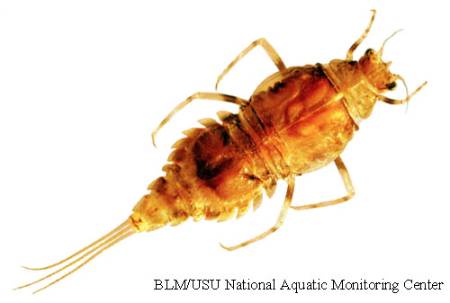 |
Quadrate shape, robust thorax, only fore wingpads. Length less than 8 mm. | Rapid moving fresh water. |
| Ephemerellidae (spiny mayflies) | 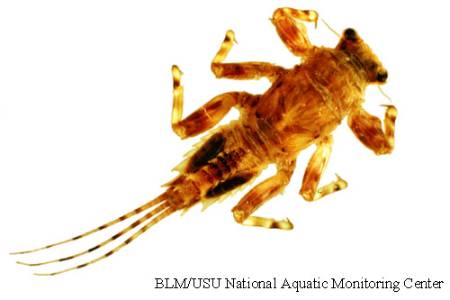 |
Gills absent on abdominal segment 2, may be absent on segments 1 and 3, spiny. Length 5-15 mm. | Mostly rapid moving fresh water. |
| Ephemeridae (burrowing mayflies) |  |
Large bodied, long mandibular tusks curve upward and outward without spines on distal end, gills forked. Length 15-35mm. | Rapid moving fresh water - large. |
| Heptageniidae (flathead mayflies) | 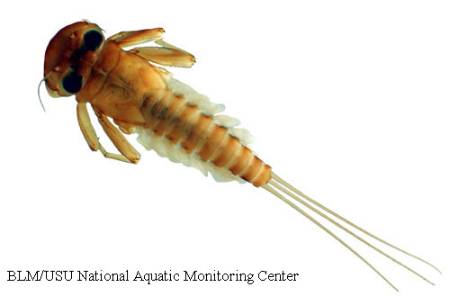 |
Dorsally flattened body, rectangular head, broad shoulders, large alien eyes. Length 5-20mm. | Rapid moving fresh water, generally higher water velocity areas. |
| Isonychiidae (brushlegged mayflies) | 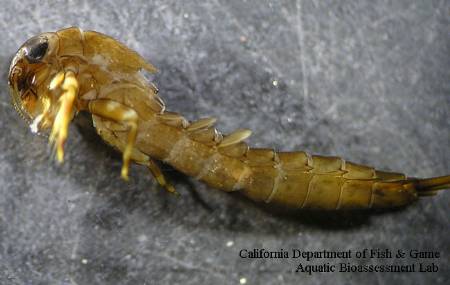 |
2 rows of conspicuous, long hairs present along inner surface of fore legs. Length 8-17 | Rapid moving fresh water. |
| Leptohyphidae (stout crawlers) | 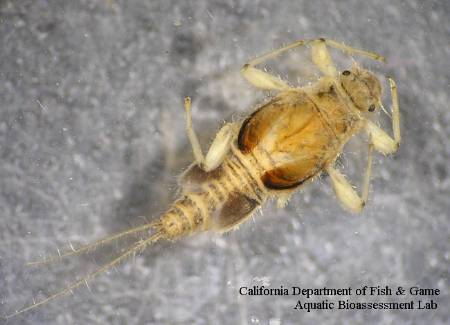 |
1st pair of gills operculate - triangular shape that do not meet in center, robust thorax. Length 3-10mm. | |
| Leptophlebiidae (prong-gilled mayflies) | 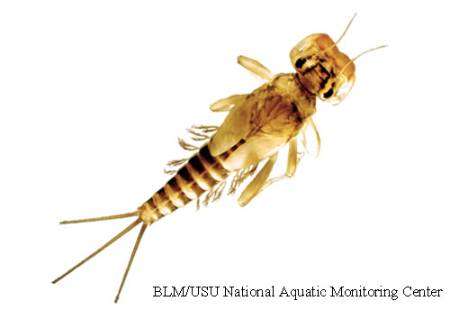 |
Body dorsoventrally flattened, gills can be forked, fringed, elongate, or double. Length 4-15 mm. | Generally rapid moving fresh water, some slow moving fresh water. |
| Oligoneuriidae | 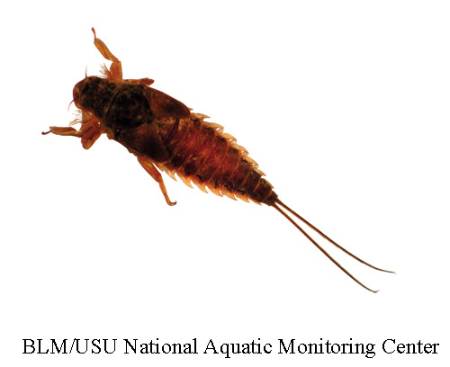 |
Front legs with long setae on inner margins. Length 8-17mm. | Larger rapid moving fresh water, depositional. |
| Polymitarcyidae (white mayflies) | 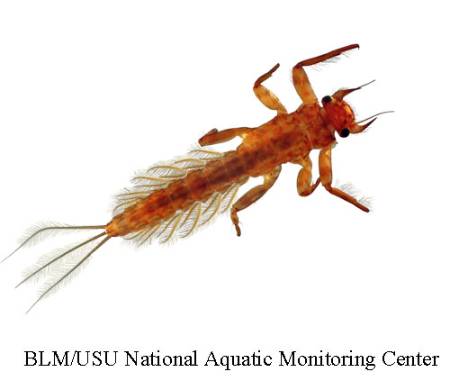 |
Large bodied, long mandibular tusks covered with spines or tubercles that curve inward and downward, gills forked and held dorsally. Length 12-35mm. | Larger warmer rapid moving fresh water, depositional. |
Plecoptera
Aquatic organisms with 2 tails, or cerci, typically belong to the Plecoptera order-- also known as stoneflies. There are 8 families of stoneflies found in Utah. Stoneflies are considered one of three indicator species because of their high intolerance to pollution. They are typically found in clear, cold mountain streams.
| Family | Picture | Description | Habitat |
|---|---|---|---|
| Capniidae (winter stoneflies) |  |
3-8 mm in size. Capniidae are small and elongate. They have parallel wing pads and relatively long cerci (tails). Adults typically emerge in winter and early spring. | Commonly occur in small mountain streams and springs. |
| Chloroperlidae (sallflies) | 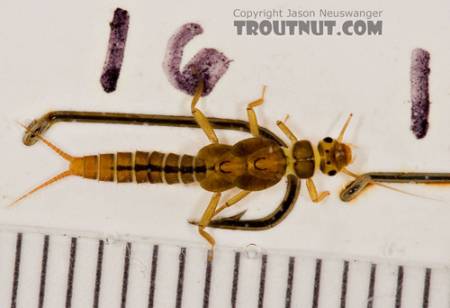 |
5-12 mm in size. Chloroperlidae generally have no distinctive pigmentation, wingpads are parallel to the body and tails are shorter than the abdomen. They lack external gills. | Most often found in cold mountain stream riffles on gravel substrate or woody debris. |
| Leuctridae (needleflies, rolled winged stoneflies) | 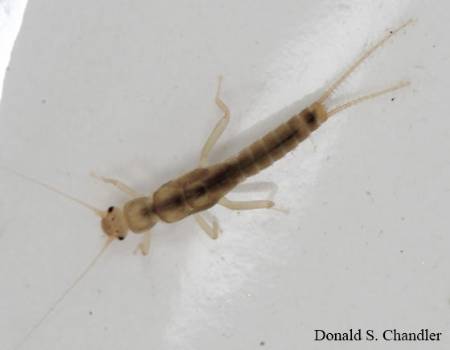 |
4-10 mm in size. Leuctridae larva have light colored, elongate bodies. Without gills. They have parallel wingpads that are longer than wide. | Commonly found in springs and small streams. Most of their time is spent burrowed deep in the substrate. |
| Nemouridae (forest flies) | 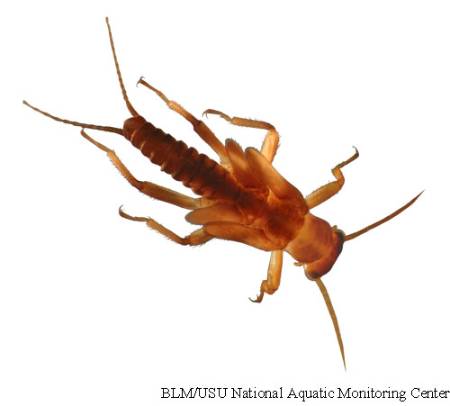 |
3-8 mm in size. Nemourdiae have small, brown, hairy bodies. Gills occur in the cervix, or neck, region. The hind legs can extend past tip of abdomen. | Commonly found in riparian debris in fast water with a coarse substrate. |
| Peltoperlidae (roach stoneflies) | 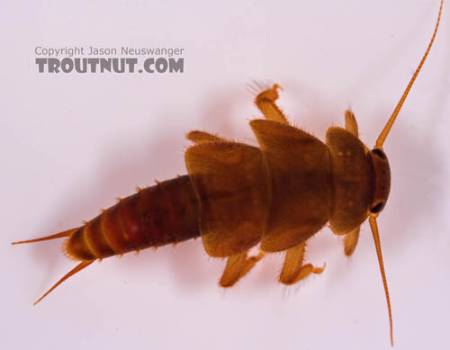 |
8-15 mm in size. Peltoperlidae are brown without distinctive patterns. They have ventral gills on the thorax and large overlapping sternal plates that give them a roach like appearance. | Commonly found in the sediments or detritus of flowing streams. |
| Perlidae (golden stoneflies) | 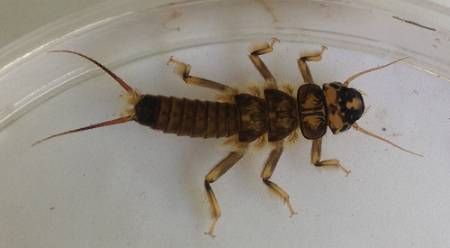 |
8-35 mm in size. Perlidae are yellow and brown and distinctly patterned. They have highly branched gills on each thoracic segment and around coxal bases (armpit), and sometimes in the anal region. | Found in a wide variety of swift moving water clinging onto rocks or crawling in moss. |
| Perlodidae (stripetails, springflies) | 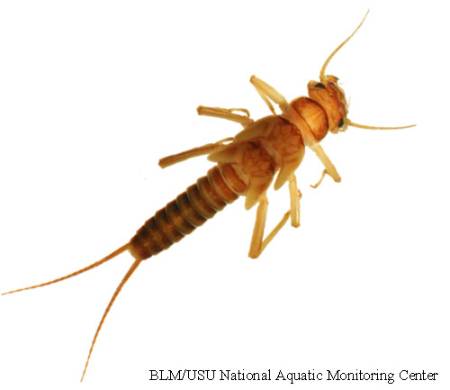 |
8-16 mm in size. Perlodidae may have contrasting light and dark patterns on their head and thorax. The cerci (tails) are generally 3/4 the length of their body. Some have simple finger-like gills on their neck, thorax, or abdomen. | Typically found on the under side of larger cobbles and boulders. |
| Ptereonarcyidae (salmonflies) | 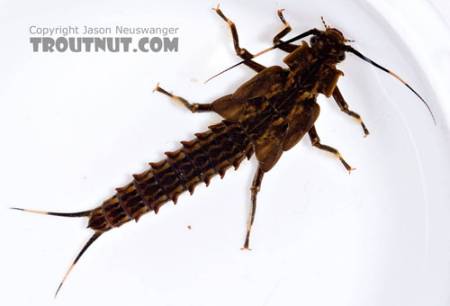 |
15-50 mm in size. Pteronarcydiae are the largest of the stone flies. They have dark brown bodies and highly branched gills on each thoracic segment and the first two abdominal segments. | Found In rapid moving fresh water in coarse leaf packs or the underside of large cobbles. |
| Taeniopterygidae | 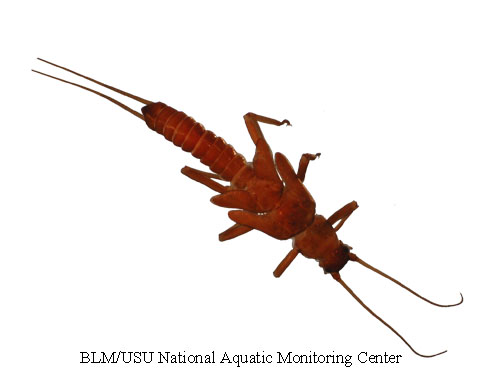 |
3-8 mm in size. Taeniiopterygidae have widely divergent wingpads. Often confused with Nemouridae, however, unlike Nemourids, the length of the 2nd tarsal segment is similar to the 1st tarsal segment. Few have a single gill near each coxae (armpit). If no gills, they have a sclerotized butt plate on the end of abdomen. | Often found in slower waters than other stone flies. Commonly found in riparian debris. |

